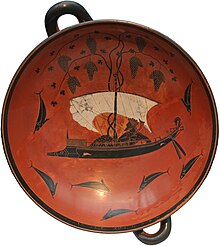Eye cup

Eye bowl is a name for a special type of bowl from ancient Greek ceramics with a pair of painted eyes on the outer wall.
Eye bowls were a type of drinking bowl ( kylix ) that was particularly widespread in Athens and Chalkis in the second half of the 6th century BC .
The pelvis of the eye-cup rests on a short stocky foot, both sides of the view are dominated by large pairs of eyes under browbones. The eyeballs are outlined, later often filled with white or painted with white on black. Some eyes are "feminine"; H. Almond-shaped without tear ducts. Often there is a stylized nose in the middle between the eyes; The inclination of the bowl when drinking made it look like a mask to the person opposite the drinker with the handles that look like ears and the underside of the foot as a mouth. Dionysian themes were usually painted between the large eyes .
An apotropaic meaning of the eyes, that is to say defensive evil, is assumed. Eye bowls were made by various painters in predominantly black-figure , later also red-figure technique. Under the early bilingual vases there are eye bowls that are painted with black figures on the inside and red figures on the outside.
The painter who introduced this type and its special painting to Attic vase art is Exekias , whose eye cup, dated around 540-530, is considered a masterpiece in Munich. It depicts Dionysus lying on a ship like a reveler. The attribute depicting him as a divine figure is a vine tendril growing along the ship's mast, the symbol of the god.
Other well-known examples of eye cups come from the following vase painters or groups:
- Amasis ; he painted some eye cups of a variant with a continuous profile (type B)
- Andokides
- Antiphon painter
- Epictetus with bilingual eye-cups
- Ghost painter
- Painter of the Nicosia-Olpe
- Heschylus
- Krokotos group
- Leafless Group ; she continued the scheme of the eye cups with late variants, which mostly dispensed with the representation of the large eyes.
- Lydos group
- Lysippides painter
- Mastos painter
- Nicosthenes
- Nikosthenes Painter
- Oltos with bilingual eye cups
- Pheidippos with bilingual eye-cups
- Scythians with bilingual eye-cups
- Group of Walters 48.42 specializing in frontal views of masks of Dionysus, satyrs or maenads between the eyes, and gorgonias inside
A special form is the chalcidizing bowl , further modifications are the FP class , the group of love-making bowls , the class of skyphoi A1 , the class of skyphoi A2 , the top band Stemlesses (stemless bowls with a black band on the upper edge and eyes in the handle zone) and probably also the segment class with black outside, but inside images over the entire inner surface.
Dating is often difficult, but eye shells are essentially from the period 540–500, possibly up to 480 BC. Known.
Eye cups were also exported to Italy in large numbers. Most eye cups were found in Etruscan burial chambers as grave goods.
supporting documents
- ^ Friedrich Wilhelm Hamdorf in: Klaus Vierneisel, Bert Kaeser (ed.): Art of the bowl - culture of drinking. 1990, pp. 419f.
- ^ A b c d e John Boardman: Black-figure vases from Athens. Philipp von Zabern, Mainz 1977, p. 118.
- ^ A b c d John Boardman: Black-figure vases from Athens. Philipp von Zabern, Mainz 1977, p. 124.
- ^ John Boardman: Black-Figure Vases from Athens. Philipp von Zabern, Mainz 1977, p. 163.
- ^ John Boardman: Black-Figure Vases from Athens. Philipp von Zabern, Mainz 1977, p. 119.
- ↑ Bettina Kratzmüller: An Attic black-figure eye cup from the earlier possession of G. Tschmelitsch . Forum Archaeologiae.
literature
- John Boardman : Black-Figure Vases from Athens. A handbook (= cultural history of the ancient world . Vol. 1). Philipp von Zabern, Mainz 1977, ISBN 3-8053-0233-9 .
- Friedrich Wilhelm Hamdorf in: Klaus Vierneisel , Bert Kaeser (Hrsg.): Art of the bowl - culture of drinking. Antikensammlungen München, Munich 1990, p. 418f.
- Norbert Kunisch : The eyes of the eye cups. In: Ancient Art . 33, 1990, pp. 20-27.
- Berthold Fellmann : Munich, antique collections, formerly the museum of antique cabaret. Volume 13: Attic black-figure eye cups (= Corpus Vasorum Antiquorum. Germany . Vol. 77). CH Beck, Munich 2004, ISBN 3-406-51960-1 .

